
Just One Thing (JOT) Webinar SeriesOctober 6, 2022
- Subject:
- Cross-Curricular
- Material Type:
- Lecture
- Author:
- Sarah Bazemore
- Date Added:
- 09/27/2022

Just One Thing (JOT) Webinar SeriesOctober 6, 2022
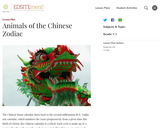
In this lesson plan, students will learn about the 12 animals of the Chinese zodiac. In the introductory first lesson, they will see how animals are often used as symbols. In the second lesson, they will hear one of several versions of how the 12 animals were chosen. They will then focus upon a few of the animals in the story and see how they can be used as symbols of certain human characteristics. In the third lesson, they will be introduced to the other animals of the zodiac, and they will be given a chart on which they will assign traits to each animal. Then they will consult a number of websites to find the traits traditionally associated with the animals, which they will add to their list. Then, they will come up with a number of ways to compare and contrast the animals in the list. In the third lesson, they will focus upon the animal associated with the year of their birth, learning about its traits and discussing whether or not these apply to themselves and their peers. Finally, each student will make an acrostic, combining the letters of his or her first name with adjectives that relate to his or her zodiac sign.
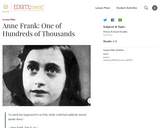
Drawing upon the online archives of the U.S. Holocaust Museum, this lesson helps students to put the events described by Anne Frank into historical perspective, and also serves as a broad overview of the Nazi conquest of Europe during World War II. After surveying the experiences of various countries under Nazi occupation, the lesson ends with activities related specifically to the Netherlands and Anne Frank.
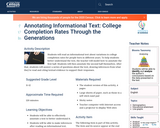
Students will read an informational text about variations in college completion rates for people born in different years. To help students better understand the text, the teacher will model how to annotate the first half. Students will then annotate the second half themselves. After that, students will answer a series of questions about the text, drawing inferences from what they've read and citing textual evidence to support their responses.
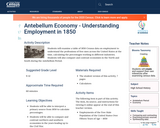
Students will examine a table of 1850 Census data on employment to understand the professions of free men across the United States at the time, calculating the percentages working in different industries. Students will also compare and contrast economies in the North and South during the Antebellum Period.
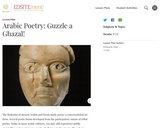
The Bedouins of ancient Arabia and Persia made poetry a conversational art form. Several poetic forms developed from the participatory nature of tribal poetry. Today in most Arabic cultures, you may still experience public storytelling and spontaneous poetry challenges in the streets. The art of turning a rhyme into sly verbal sparring is considered a mark of intelligence and a badge of honor. Students will learn about the origins and structure of Arabic Poetry.

Cross curricular lesson plan integrating Computer Science, Science, and English Standards CS 4.5 Science 4.3 English 4.4a, 4.8a

information for parents, students, and staff

Students will categorize attribute blocks based on their color, thickness and/or size. Optionally, connections to categorizing will be related to robots (e.g. looks, motions, sounds) and coding.

Australian Aboriginal art is one of the oldest continuing art traditions in the world. Much of the most important knowledge of aboriginal society was conveyed through different kinds of storytelling—including narratives that were spoken, performed as dances or songs, and those that were painted. In this lesson students will learn about the Aboriginal storytelling tradition through the spoken word and through visual culture. They will have the opportunity to hear stories of the Dreamtime told by the Aboriginal people, as well as to investigate Aboriginal storytelling in contemporary dot paintings.

Comparing Numbers Game
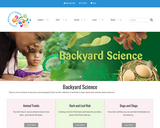
There is a lot of science to discover in your backyard! Check out this collection of activities to learn about wind, animals, plants and more.
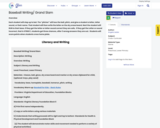
Each student will step up to bat. The “pitcher” will toss the ball, pitch, and give a student a letter, letter sound, or their name. That student will then write the letter on the dry erase board. Next the student will RUN to their base. If they get the letter or letter sound correct they are safe, If they get the Letter or sound incorrect, that is STRIKE 1, students get three chances, after 3 wrong answers they are out. Students will score points when students cross home plate.
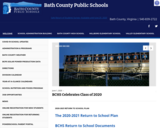
Links to 20-21 Return to School Plan and documents/information for students and parents.
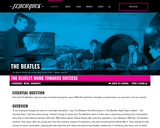
"A lot of people thought we were an overnight sensation," says The Beatles' Paul McCartney in The Beatles: Eight Days a Week “The Touring Years," "but they were wrong." Indeed, though to many fans The Beatles seem to have been a big bang, bursting from Liverpudlian obscurity to international stardom with their 1963 debut album Please Please Me, quite the opposite is true. Between 1960-63, The Beatles worked. They were, after all, young men from the working classes of Liverpool, a city still recovering from World War II. They worked to earn money for basic necessities, playing pub sets both day and night and performing lengthy residencies in Hamburg, Germany, one of which included a stretch of 104 consecutive shows. They worked on repertoire, learning dozens of "cover" songs spanning several genres. They worked on their group sound, playing several sets a night and fine tuning the skills that helped them "hold" audiences at the dance floor, even those who may not have come specifically to see them.
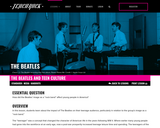
In this lesson, students learn about the impact of The Beatles on their teenage audience, particularly in relation to the group's image as a "rock band."
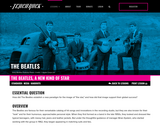
Essential Question: How did The Beatles establish a new paradigm for the image of "the star," and how did that image support their global success?
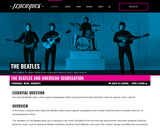
In this lesson, students learn about the Beatles active stance against segregation and consider what the band's example meant for an emerging youth culture.
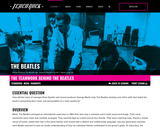
This lesson explores first the role Brian Epstein played in helping craft The Beatles' visual presence, group identity and team unity, the way he helped the group transition from successful nightclub act to international sensation.